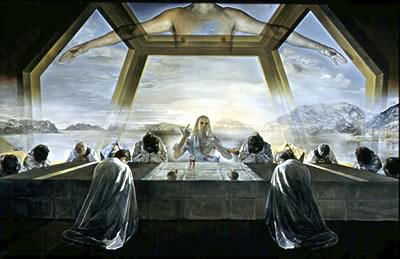Sal’s post on Jews for Jesus reminded me that one of their members gave me a pamphlet today, and I want to send them a thank-you note. Although I’d rather they were Catholic, it’s infinitely better to be baptized Protestant than not to be baptized at all, and I admire them canvassing for recruits in Lafayette Park, right across from the White House.
It also reminded me of the original Jews for Jesus:

13 comments
Comments are closed.

Hello, Dali!
Jews for Jesus
11623 Nebel St
Rockville, MD 20852
Salvador Dali will go down as one of the greatest painters of the 20th century, because of works like this. I bet he’ll be remembered and studied long after Picasso is a footnote…
The National Gallery of Art, where this painting hangs, put it at the top of an escalator for some reason, so people jostle you from behind as you look at it. Which is too bad, because the level of detail is astonishing. You can see the bread’s fine texture and the small creases of the table linen. It’s breathtaking.
It’s instructive that the National Gallery of Art’s West Building has room after room of French impressionists, whose work is certainly of historical importance–but hangs a significant Dali painting in a stairwell. At least it’s in the main building, instead of the awful East Building.
Regarding Jews for Jesus, they deserve a great deal of respect for their courage. What they must suffer from their families, especially if the families are of the secularized mindset. Religious Jews at least have theological reasons to be opposed to a Messianic Jewish group, but I get the impression that it’s the liberal, secularized Jews who really despise them and are the ones complaining to the radio stations, etc.
I wouldn’t read too much into the placement, Beregond. Logically, it belongs with the (mostly) modern works in the East building, but they grouped it with the masters in the West. Also, it’s a huge canvas, and would look out of place in the wood-paneled rooms. I wish they would put it in one of the end corridors, the way they do for some of the other large-scale paintings.
Most likely, your assessment of the criticism’s source is correct. It seems the less a Jew is interested in Judaism, the more he is interested in Jewishness. That’s been my personal experience, at least.
Wow … someone else who prefers Dali to Picasso (not that Picasso ain’t great … but Dali’s rep has suffered because of his public persona and his style being glossy and accessible, rather than academic).
On the other hand, a sense of beauty and humanity comes across in Dali, which I think is lacking in the misogynistic Picasso.
Picasso’s work was eclectic — the guy lived almost a century, and painted almost to the end — and he sporadically turned his hands back to beauty. His early figural works are deeply human, and you can tell he sympathizes with his subjects and listens to what goes on in their souls.
It’s his later works, when he is either throwing the rotten fruit of his warped psyche on the canvas, or disfiguring the (usually female) human body that he began to transform into the monster he became.
Has anyone seen the movie “Spellbound,” with Ingrid Bergman and Gregory Peck. Dali did the set pieces for the dream sequences, which are both rivetting and frightening in their beauty and presentation of dream imagery.
But it’s his religious paintings – the temptation of St. Anthony, the Christ of St. John of the Cross and the Sacrament of the Last Supper in particular – that drew me in completely. Profound.
Tim:
SPELLBOUND is not generally considered one of Hitchcock’s best — Gregory Peck isn’t really his type of actor and the story’s basic ludicrousness (nobody at a mental home even knows the world-famous psychiatrist to recognize?) is too much even for the director of NORTH BY NORTHWEST to handle. But everyone agrees the Dali dream sequences are the best part of the film, making the commonplace seem strange from desolate isolation and then strange movements. Hitch was willing to subordinate his own obsessions to some of Dali’s (the eye-slicing, for example).
Ironically, Dali and Hitchcock for a long time enjoyed similar reputations among the cognoscenti (or at least that part of the pre-1960s cognoscenti who deigned to acknowledge movies) — as makers of slick, crowd-pleasing shockers; as outsized “characters” whose metier was publicity and put-on rather than art; as artists not radical enough to put real bite in their ultimately hollow contraptions.
Good comment as always, Victor. I never knew that parallel between Dali and Hitchcock. I guess I assumed their reputations as geniuses and innovators were contemporary to their lives.
Tim, I also started to like Dali because of his religious paintings. I had seen the famous ones like “Persistence of Memory” and assumed they were all like that. When I saw his religious works, I kept looking intently for the joke until I realized he was utterly serious.
Dali had his own “Picasso”esque moments as well. Although Persistence is a really good non-religious piece, he also made some rather, well, odd pieces to say the least. His religious pieces, which came during a relatively normal period of his life (and, incidentally, a concerted effort of his to return to the “masters”), were outstanding.